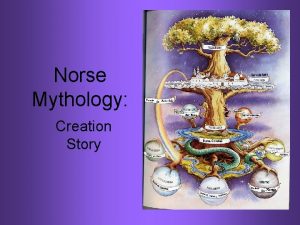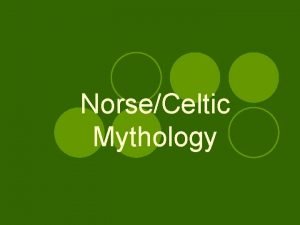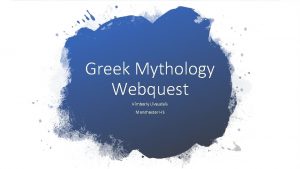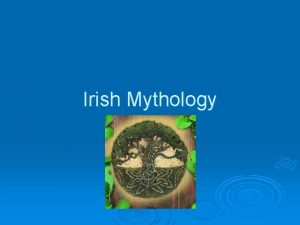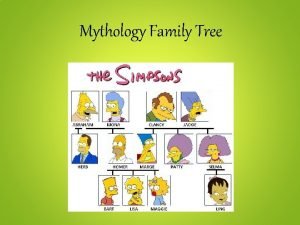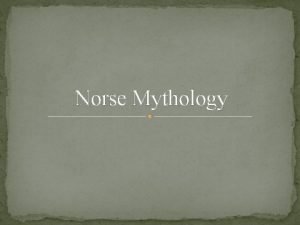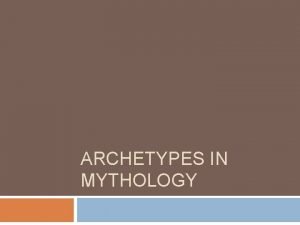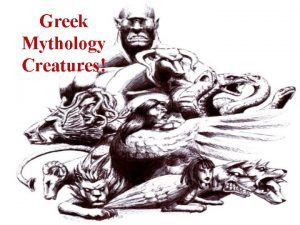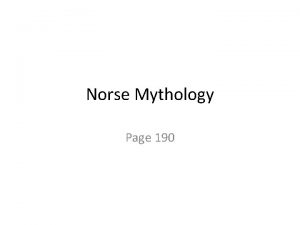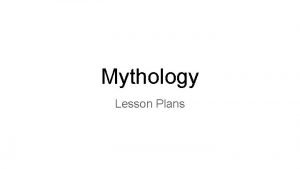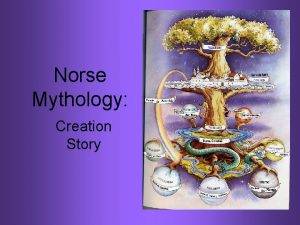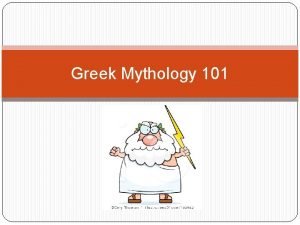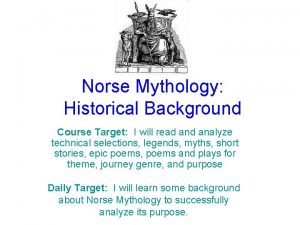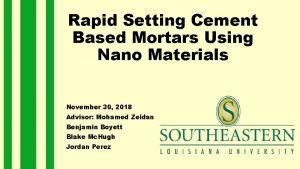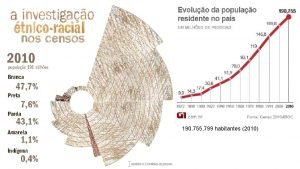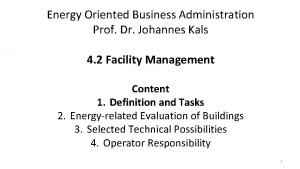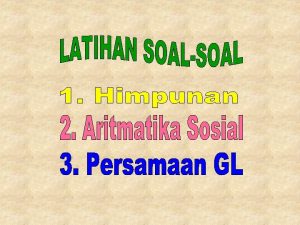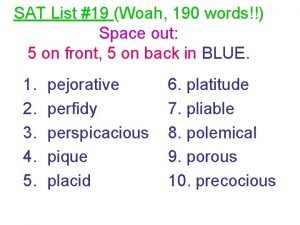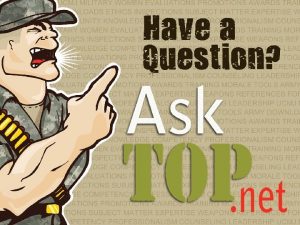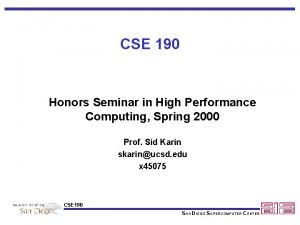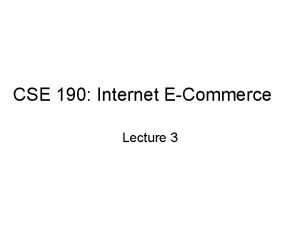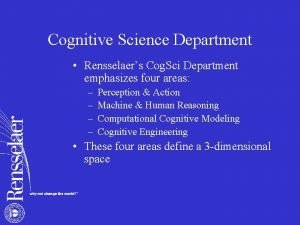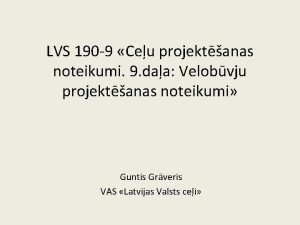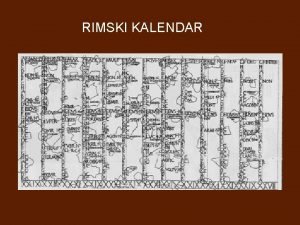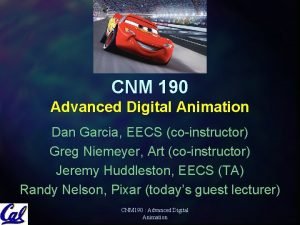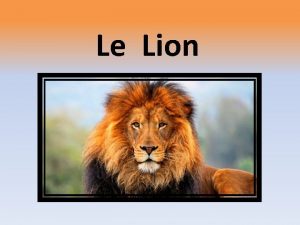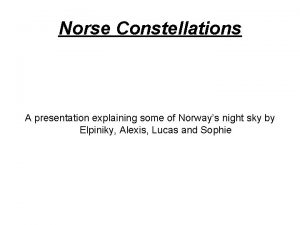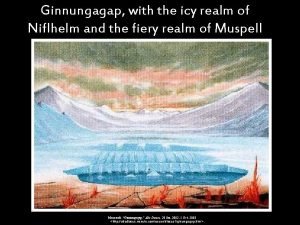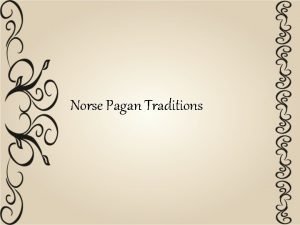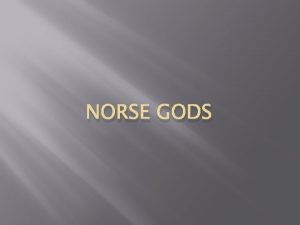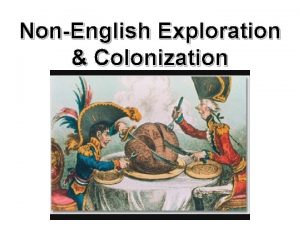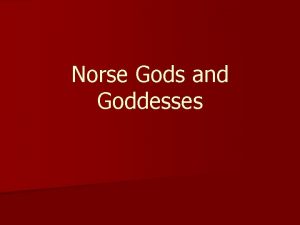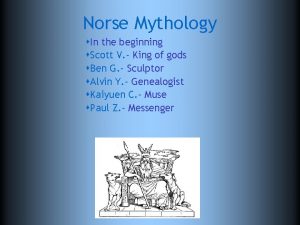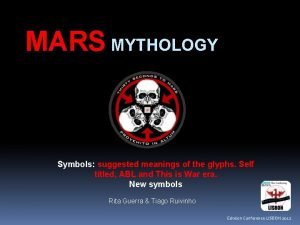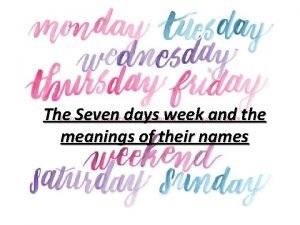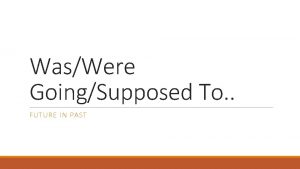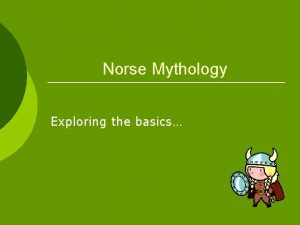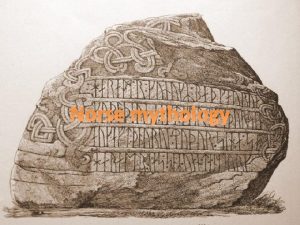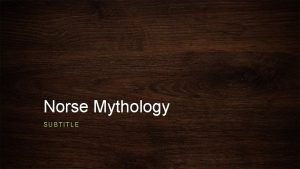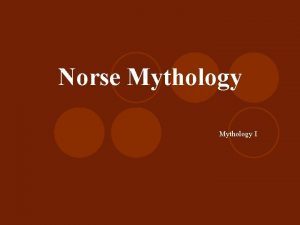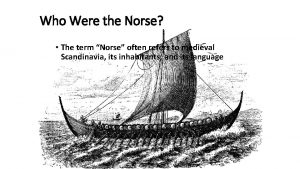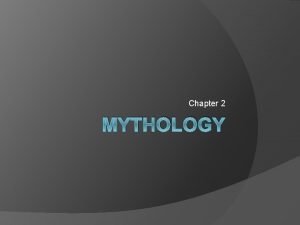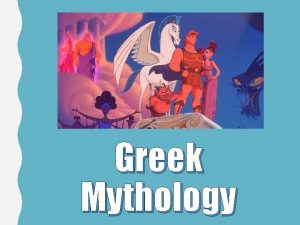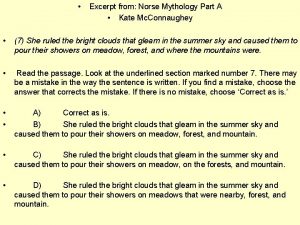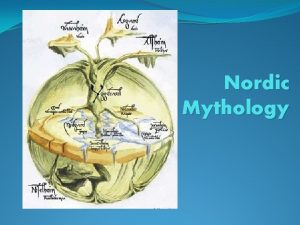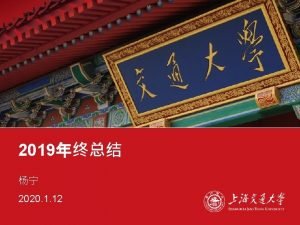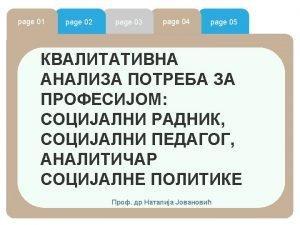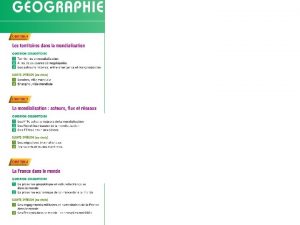Norse Mythology Page 190 Who were the Norse


















































- Slides: 50

Norse Mythology Page 190

Who were the Norse? • The Norse were tribes that inhabited Northern Europe, specifically Norway, Sweden, Finland, and Denmark. • Historically, the Norse were know by the term “Viking” and were famous for their raids along the British Isles and continental Europe.

How Do We Know What We Know? • Norse myths existed only in oral form while they were central to religious belief. They were written down after Northern Europe had become Christian. • However this presents a few problems: – There is no coherent body of literature showing the myths and legends – There could possibly be alterations due to the influence of Christianity – The “fictionalization” of stories which originally had religious importance – Therewas a wide time span, wide geographical range, and many different sub-cultures.

Recorded Sources • There are some sources that were recorded and we are pretty sure have not been altered. • Prose Edda and Poetic Edda are where most of our ideas about the Norse religion come from. • However, unlike most myths, we know exactly who wrote these Eddas…Snorri Sturluson in the 13 th centaury.

Norse Creation Myth • Ginnungagap was the great emptiness before there was a world, or any living things in it. • Far to the South of the Ginnungagap was the fiery realm of Muspell. • With its long, hot rivers full of poison and vast lakes of fire, nothing could grow in Muspell.

Norse Creation Myth • To the North was the dark and cold realm of Niflheim, where icy fountains spewed forth freezing rivers. • Nothing could grow here either, for the sky was always dark and the mountains were blocks of solid ice.

Norse Creation Myth • Slowly, over years and years, the fiery blasts from Muspell began to melt the icy mountains of Niflheim. • Out of the melting ice, the giant Ymir emerged, the first being of the vast Ginnungagap.

Norse Creation Myth • Next to him there emerged a cow from the ice. • The cow licked the salt from the ice mountains and Ymir drank the cow’s milk. • The cow licked away entire mountains of ice. Slowly she licked the ice from two more beings, this time the god Buri and his goddess wife. • They had a son named Bor, and his son was named Odin, who became the king of all the gods.

Norse Creation Myth • Ymir was cruel and brutal. • Odin and the other gods could no longer abide by his evil acts and together the gods slew him. • Ymir’s huge body formed the earth. His blood became the sea, his flesh became the land, his bones the mountains and his hair the trees. • Odin and the other gods formed the sky with his skull, held up by four towering pillars.

Norse Creation Myth • Odin gathered sparks from the fiery depths of Muspell and created the sun and moon and set them in the sky. • As the sun and moon shone over the new world in the Ginnungagap, the ice began to melt and plants and trees began to grow.

Norse Creation Myth • The greatest tree of all was the Yggdrasil, which grew in the very center of the earth. • Its roots penetrated into the bottom of creation and its leaves reached the very top of the sky. • Odin was satisfied with the new world, and named it Midgard, ‘The Middle Land’.

Norse Creation Myth • On one of his walks, Odin found two fallen trees, an ash and an elm. • He lifted them from the mud and formed the first man and woman from them. • Odin breathed life into the beings, gave them reason and feelings, hearing and sight. • He named the man Ask and the woman Embla. From these two sprang the entire human race. • The humans had the task of looking after Midgard, while the gods ascended to Asgard (their realm in heaven).

Norse Creation Myth • Ymir’s giant sisters were still mourning his death and were looking for a way to take their revenge on the gods who killed him. • They gathered at the foot of Yggdrasil and began carving lines into it. • Each line was a human life, filled with twists and turns, beginning with a man’s birth, and ending with his death. • At the end of each line they made a deep cut to ensure that humans would never be as powerful as the gods. • These spells were so powerful that not even Odin could do anything to change them. • Thus Yggdrasil became known as ‘The Tree of Life’ and humans knew death and suffering in their world.

Different Deities • There were actually two distinct division among the gods of Norse mythology. • The Aesir make up the principle gods of the pantheon and were connected to power and war. • The Vanir appear to mainly be connected to cultivation and fertility. • Over time both groups would merge with the Aesir gods being the dominate.

Nine Worlds • There were nine separate worlds to the Norse that made up the cosmos. • Midgard (where the humans dwelt) • Asgard (this is the capitol of the Norse Gods and where most of the myths take place). • Hel (the underworld) • The other six worlds are referred to, but play no big part in the major myths.

Valhalla • Odin’s Hall • The home of those slain gloriously in battle. • There idea of heaven where you prepared to fight at the end of the world.

Gods and Goddess

Odin • Chief God • God of wisdom, war, battle and death (among other things) • Had one eye. Gave an eye for wisdom • Odin’s weapon of choice was a spear (Gungnir) and he rode Sleipnir (an eightlegged horse).

Frigg • Wife of Odin • Patron of marriage, motherhood and fertility. • Plays little part in the myths.

Thor • Son of Odin • Red Haired and Bearded • God of thunder (as well as lightening, wind and rain) and war. • Weapon of choice was a special crafted war hammer, Mjolnir. • Hammer was crafted by the dwarfs of Asgard.

Sif • Golden haired wife of Thor. • Fertility goddess • Plays little part in the myths.

Tyr • God of single combat and heroic glory. • Bound the great wolf Fenrir. • One hand (lost the other to the wolf Fenrir) • Bravest of the Gods.


Heimdall • Guardian of the Gods • Watches over the Bifrost Bridge (connects the worlds together). • Could see perfectly for hundreds of miles in the day or night. • Needed no sleep. • Blows his warning horn if trouble approaches • Will only blow his horn once in all the myths.

Freyr • One of the most important Norse Gods • God of Fertility • Carried a magic sword

Freya • Goddess of love and fertility. • The most beautiful of the goddesses • Patron of crops and childbirth.

Baldr • God of innocence, joy, beauty and peace. • Odin’s second son. • Invulnerable to everything, except mistletoe • Killed by his blind brother Hoor, who was tricked by Loki • Death begins the prophecy for the end of the world

Hoor/Hod • God of winter and darkness • Blind • Tricked by Loki into killing Balder

Vidar • God of Silence • God of Revenge

Uller • God of the Winter. • Always dressed in animal furs. • Patron of the western mountains.

Valkyrie • Goddess of combat • Rode over the battlefields to choose those slain gloriously in battle. • They choose who got to go to Valhalla.

Forces of Chaos • There are several forces that are constantly fighting the gods but among them only six are prominent. – Frost Giants – Fire Giants – Loki’s three children

Loki • • God of Mischief Odin’s brother Prankster Has three child who are the greatest monsters in the known world.

Loki’s Brood

Fenrir • A massive wolf • Capable of breaking any bonds • Special bond was made by the gods and Tyr bound the monster.

Jörmungandr (World Serpent) • A massive snake with venomous breath. • Cast down into the oceans of Midgard where he became so large his body circled the world • The arch-enemy of Thor

Hel • A female with half a face like a beautiful woman and the other half of her face like a corpse. • Ruler of Hel (the place), the Viking underworld. • Companion her hellhound Garm.

Ragnarok • • The Viking Armageddon Introduced by the birth of Loki’s three children. Triggered by the death of Baldr. Fought during three consecutive winters.

Loki’s Punishment • Punished for the death of Baldr, Loki is tied to a rock where a snake spits venom onto his face everyday. • However a great earthquake will break all the bonds in the universe and the battle of Ragnorak will begin.


Final Battle • At Ragnarok, the sons of Muspell (fire giants) shatter the Bifrost Bridge. • Loki leads the rest of the giants toward Valhalla for the final battle of the world.

Final Battle • Odin will fight Fenrir, but after a long battle will be eaten by the great wolf. • To avenge his fallen father, Tyr kills the beast by ripping its jaws apart.

Final Battle • Thor will fight the world serpent and kill it, but will only be able to take 9 steps back before dying from the creature’s venom.

Final Battle • Tyr will fight the hellhound Garm, and the two will slay each other • With Garm dead, there is no guardian of Hel so the dead warriors not in Valhalla rise to fight.

Final Battle • Heimdall and Loki with fight and kill each other.

Final Battle • Brandishing the Sword of Vengeance, Surtr (the great fire giant) will burn all 9 worlds of the Norse universe. • The fire will destroy everything, including himself • Thus ends the world

The End? • Although Surtr destroys the world, this is not the end. • The earth reemerges and the sons of the gods as well as two humans (a male and female) emerge from Yggdrasil and begin to repopulate the world. • A newer and a fairer sun will arise symbolizing the completion of a perfect world.

Heroes

Sigurd/Seigfried the Dragon Slayer • Sigurd the Dragon Slayer is the hero of the anonymous 13 th century Icelandic prose epic, Völsunga saga, based on legends of Old Scandinavian folk culture. • Slays the dragon Fafnir to claim a dragon’s hoard.

Beowulf • An Anglo-Saxon hero chronicled in the epic poem Beowulf from the 8 th centaury. • Kills three monstrous beings: Grendel, Grendel’s Mother, and a Dragon. • Embodies the ideals of the Norse culture. • Considered the first piece of written literature of what would become English.
 Norse mythology creation story
Norse mythology creation story Norse religion
Norse religion Norsecelts
Norsecelts Norse mythology webquest
Norse mythology webquest Finn norse mythology
Finn norse mythology Norse god family tree
Norse god family tree Norse mythology terms
Norse mythology terms Archetypes in norse mythology
Archetypes in norse mythology λερναια υδρα
λερναια υδρα Norse blind god
Norse blind god Norse mythology lesson plans
Norse mythology lesson plans Norse mythology creation story
Norse mythology creation story What is a myth
What is a myth Norse mythology course
Norse mythology course Running header apa
Running header apa A crate is being lifted into a truck
A crate is being lifted into a truck Adva 190
Adva 190 190 755 799
190 755 799 Gefma betreiberverantwortung
Gefma betreiberverantwortung Me 190 sjsu
Me 190 sjsu Jika s = bilangan asli
Jika s = bilangan asli 190 words
190 words Da form 2823
Da form 2823 Telescience museum
Telescience museum Cse 190
Cse 190 Vertical mill
Vertical mill Cogsci 190
Cogsci 190 Doti
Doti Svi rimski brojevi
Svi rimski brojevi Cnm 190
Cnm 190 190 vauxhall bridge road mental health
190 vauxhall bridge road mental health Lion poids 130 kg
Lion poids 130 kg Norse constellations
Norse constellations Niflhelm
Niflhelm Viking beliefs
Viking beliefs Norse god of thunder
Norse god of thunder Santa mara length
Santa mara length Norse referral login
Norse referral login Blind son of odin
Blind son of odin Odin family tree
Odin family tree Mars glyph
Mars glyph Week names
Week names Was were going to future in the past
Was were going to future in the past Công thức tính độ biến thiên đông lượng
Công thức tính độ biến thiên đông lượng Hát kết hợp bộ gõ cơ thể
Hát kết hợp bộ gõ cơ thể Tỉ lệ cơ thể trẻ em
Tỉ lệ cơ thể trẻ em Thế nào là mạng điện lắp đặt kiểu nổi
Thế nào là mạng điện lắp đặt kiểu nổi Các loại đột biến cấu trúc nhiễm sắc thể
Các loại đột biến cấu trúc nhiễm sắc thể Lời thề hippocrates
Lời thề hippocrates Vẽ hình chiếu đứng bằng cạnh của vật thể
Vẽ hình chiếu đứng bằng cạnh của vật thể độ dài liên kết
độ dài liên kết
